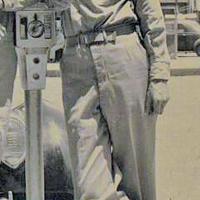Joe Heitman served in the Army Air Corps during World War II. The photo was taken circa 1943.
They were known by some as “Kirkwood’s Flyboys.” Growing up on West Washington Avenue, they had occasion to use the nearby city park for biking, sledding and later, as their personal airport.
That’s right: Kirkwood’s answer to Wilbur and Orville Wright built a biplane from a kit and turned the park, now used for the annual Greentree Festival, into Kitty Hawk.
“Uncle Joe and his brother Harvey were explorers, hunters, builders and experimenters,” said Jim Heines, who lives in the 500 block of West Adams Avenue where the boys grew up in the late 1920s. “Times were different and the neighborhood was sure different.”
The neighborhood was the heavily wooded Sugar Creek Valley, a pristine area with far fewer homes than exist in the area today. The two boys were Sugar Creek trappers who sold pelts to fund their building projects, including the biplane kit.
A biplane is a fixed-wing aircraft with two main wings stacked one above the other. The first powered airplane to ever fly was the Wright Flyer. The Wright aircraft used a biplane wing configuration, as did most airplanes in America’s early years of aviation.
“Here’s the thing,” said Heines. “Once you build your own plane, where are you going to fly it? Those two boys thought Kirkwood Park was a perfect airfield. And it was — until the city officials got wind of it.
“They stayed low in the air and headed west where it would not be seen as much,” Heines added. “They also kept their biplane in an old barn on Woodlawn Avenue whenever it wasn’t flying.”
The boys’ full names were Joe Heitman and Harvey Heitman. Heines said family lore maintains that the biplane didn’t fly much higher than a hummingbird or much faster than a crow.
Heines himself worked on mechanical issues as a foreman in Glendale’s public works department for 10 years. He continues to do some mechanical maintenance now as the director of public works in Creve Coeur.
Ready For World War II
Kirkwood’s two flyers were both ready for military service when conflict erupted overseas in World War II. Heines said he knows more about “Uncle Joe,” because Harvey Heitman died when Heinz was still a youngster.
“Uncle Joe was an electrician prior to the war,” said Heines. “He was a master at engine repair. Joe and Harvey always were tinkering in their barn on Woodlawn on some contraption.
“With Joe’s electrical background and ability to repair anything, he entered the Army Air Corps in 1943,” Heines continued. “He was assigned as a flight engineer. He returned to work for Kirkwood as an electrician after the war and met my Aunt Lucille there, who he married in 1949.”
According to Heines, Joe Heitman left his Kirkwood job to work for a score of years at McDonnell Douglas Corporation in St. Louis. He worked on advanced fighter jets, as well as on the Gemini Capsule for the United States space program.
“It made sense that he would work on cutting-edge aviation,” said Heines. “After all, when he was young, he took the streetcar to the airport to see the planes and even helped Charles Lindbergh load mail into his plane.”
Heines said even though Uncle Joe’s head was usually in the clouds, he was also happy to be in a boat fly fishing.
“He was a good friend of George Carson, who some people will recall from the George Carson Outdoors’ TV show,” said Heines. “He was a fly tying and rod and reel instructor for Carson’s seminars with the Missouri Department of Conservation as well.”

Lori Gilley and her brother, Jim Heines, walk in the green space near the tennis courts at Kirkwood Park, the location where brothers Joe and Harvey Heitman flew their biplane. | photo by Ursula Ruhl
Niece Recalls Joe & Harvey
Kirkwood’s Lori Gilley, niece of Joe and Harvey Heitman, explained that the two weren’t always interested in the same things. Joe Heitman liked vehicles with propellers for air travel. Harvey Heitman preferred vehicles on roadways.
“Joe had a basement full of model airplanes that he built and could fly,” said Gilley. “Harvey had go-carts and was always tinkering with those for fun. They made a good pair.
“They were good with their hands at a young age and were very mechanically-oriented,” added Gilley. “It paid off for them later in life, both professionally and from a recreation standpoint.”
Gilley recalled that Harvey Heitman built gyro-copters as a hobbyist later in life. He would take them to the Lake of the Ozarks and fly them over the water. His wife, Ruth Heitman, would drive an outboard motor boat and tried to keep up with him in case there was a watery landing.
Gyrocopters, also known as gyroplanes, are sort of like flying go-carts. Although they look similar to helicopters, their construction and mechanics are totally different.
“Those two, Joe and Harvey, were really something — from the very beginning — as kids,” said Gilley. “They knew how to use their imaginations, solve problems and build contraptions that were a lot of fun.”
Heines laments that today’s kids do not seem to have the same freedom and outlets for fun as did Uncle Joe and Harvey Heitman. Kids now are “all thumbs,” sending social media messages on cell phones or sending directions on joysticks to their video games.
“I have tried to impart a little bit of the spirit of Uncle Joe and Harvey in raising my own kids,” said Heines. “They have had plenty of outdoor experiences with hunting, fishing and more.
“I’ve tried to pass on Joe’s rod building and fly-tying skills,” added Heines. “He taught me that stuff when I was a boy growing up in Kirkwood.”
Credit: Source link































